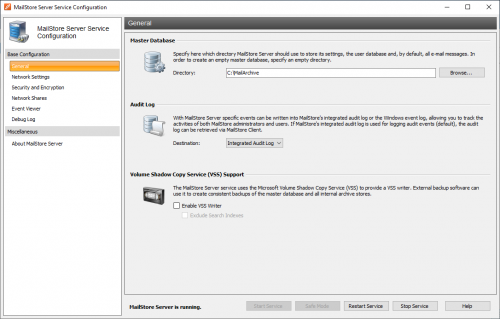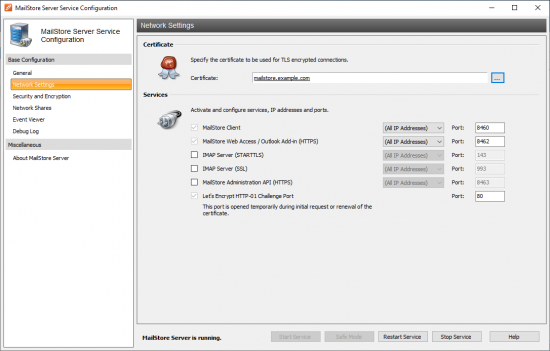Difference between revisions of "MailStore Server Service Configuration"
| [unchecked revision] | [unchecked revision] |
Ltalaschus (talk | contribs) |
|||
| Line 61: | Line 61: | ||
=== Restore Default Admin === | === Restore Default Admin === | ||
| − | Through this feature you can restore the default admin user ''admin'' with the likewise password ''admin''. If the recovery key of the archive whose default admin you want to restore is not the product key of the current MailStore Server installation, you will be asked to enter the associated recovery key.<br/> | + | Through this feature you can restore the default admin user ''admin'' with the likewise password ''admin''. If the recovery key of the archive whose default admin you want to restore is not the product key of the current MailStore Server installation, you will be asked to enter the associated recovery key.<br /> |
A restore of the default admin user is written into the audit log. | A restore of the default admin user is written into the audit log. | ||
Revision as of 09:20, 27 April 2017
With the MailStore Server Service Configuration you can configure low level features of a MailStore Server installation as well as control the MailStore Server service. The current status of the MailStore Server service is shown at the bottom of the window.
General
On this page you can select the storage location of the master database, configure where audit events should be stored and enable or disable individual features for accessing MailStore Server.
Master Database
Select the storage location of an existing master database. If you chose an empty directory, a new master database will be created therein. If you want to move an existing archive to a new storage location, refer to the instructions in Moving the Archive.
You can also specify the destination for logging audit events here.
Features
In this section you can enable or disable individual features for accessing MailStore Server.
- MailStore Web Access / Outlook Add-In (HTTP)
Enables archive access via HTTP through MailStore Web Access and the MailStore Outlook Add-in. - MailStore Web Access / Outlook Add-In (HTTPS)
Enables archive access via HTTPS through MailStore Web Access and the MailStore Outlook Add-in. - IMAP Server (unencrypted / STARTTLS)
Enables both unencrypted and STARTTLS-encrypted archive access through the integrated IMAP server. - IMAP Server (SSL)
Enables SSL-encrypted archive access through the integrated IMAP server. - MailStore Administration API (HTTPS)
Enables the MailStore Administration API. - VSS Writer
Activates the MailStore Volume Shadow Service Writer for enabling live backups of the archive using an external backup software.- Exclude Indexes from VSS Backup
Location of index files will not be reported by the VSS Writer.
- Exclude Indexes from VSS Backup
IP Addresses and Ports
In addition to enabling and disabling individual network based components, you can choose the IP address and the port to which a component is to be bound as well as the SSL certificate that should be used for encrypted connections.
Basic Options
IP Address
The IP address on which the component accepts connections. Generally, it is recommended to bind all MailStore Server components to all IP addresses (default).
Port
Indicates the TCP port on which the component accepts connections.
- Hint: If no web server other than MailStore Web Access is installed (e.g. an IIS website, Microsoft Outlook Web Access or SharePoint), you can specify the HTTP- and HTTPS standard ports (80 and 443). This way, users can access MailStore Web access directly using the URLs
http://<server name>orhttps://<server name>without port numbers.
Server Certificate
Shows the current SSL certificate for the respective component. Click on the name of the SSL certificate to view further details. Using the ellipsis button (…) next to the name you can:
- Select an SSL certificate from the certificate store of the MailStore Server computer.
- Create a new self-signed SSL certificate.
- Import an SSL certificate from a file directly into the certificate store of the MailStore Server computer. The file must be in PKCS #12 format and usually has the file extension pfx or p12.
Specific Options
MailStore Client
You cannot disable this component because the MailStore Client is essential for managing MailStore Server. The default TCP port is 8460.
MailStore Web Access / Outlook Add-in (HTTP)
This component provides unencrypted archive access through MailStore Web Access and the MailStore Outlook Add-in. The default TCP port is 8461.
- Enable HTTPS redirect
Enabling this option redirects unencrypted HTTP requests to the HTTPS port. - Redirect to custom server name
If MailStore Server should use a specific server name for the HTTPS redirect, it must be specified here.
MailStore Web Access / Outlook Add-in (HTTPS)
This component provides SSL-encrypted archive access through MailStore Web Access and the MailStore Outlook Add-in. The default TCP port is 8462.
IMAP Server (unverschlüsselt / STARTTLS)
This component provides both unencrypted and STARTTLS-encrypted archive access through the integrated IMAP server. The default TCP port is 143.
IMAP Server (SSL)
This component provides SSL-encrypted archive access through the integrated IMAP server. The default TCP port is 993.
MailStore Administration API (HTTPS)
This component provides SSL-encrypted access to the MailStore Administration API. The default TCP port is 8463.
Security and Encryption
This page provides several security features related to archive access and encryption. Please note that you cannot use these features while the MailStore Server service is running; it has to be stopped first.
Restore Default Admin
Through this feature you can restore the default admin user admin with the likewise password admin. If the recovery key of the archive whose default admin you want to restore is not the product key of the current MailStore Server installation, you will be asked to enter the associated recovery key.
A restore of the default admin user is written into the audit log.
Reinitialize Archive Encryption
For security reasons the archive encryption is bound to the Windows installation of the MailStore Server machine. Therefore it might be necessary to reinitialize the archive encryption when moving the archive to another computer. If the recovery key of the archive whose encryption you want to reinitialize is not the product key of the current MailStore Server installation, you will be asked to enter the associated recovery key.
Set Recovery Key
The recovery key is used to authorize several security related tasks in MailStore Server, such as restoring the default admin, moving the archive to another machine or attaching archive stores from another MailStore installation. That way the number of people that may perform such tasks can be kept small and administrative archive and system duties can be kept separate.
By default, MailStore Server uses the product key provided during setup as recovery key and most security related tasks are carried out automatically without the need to enter the recovery key for authorization.
To improve security you can change your recovery key to an automatically generated, random value. In that case, every security related tasks must be authorized by entering the recovery key. For easier reference, each recovery key has a unique identifier that is displayed when the related recovery key must be provided. Only the most recent recovery key can be used for authorization.
Changing the Recovery Key
- Click on Change to change the recovery key to an automatically generated, random value.
- You will be asked to save the recovery key to a file and/or print it. You have to choose at least one option to continue.
- After successfully changing the recovery key only the new key can be used henceforth.
Important notice: Always store the recovery key in a secure location. Without the recovery key carrying out security related tasks is no longer possible.
Resetting the Recovery Key
You can reset the recovery key to the current product key of your MailStore Server installation at any time. Before the reset you will be asked to enter the current recovery key. By default, MailStore Server already uses the current product key as recovery key and the button is disabled.
Startup Script
The MailStore Server service can execute a script before startup. The script can be used to establish a connection to a network resource using special connection parameters as described in chapter Using Network Attached Storage (NAS).
Event Viewer
Events such as starting or stopping the MailStore Server service are displayed here. If there are any errors, click on the corresponding entry to view additional details below the list.
Debug Log
On this page you can enable, view or delete all debug logs created by MailStore Server.
Enable Debug Log
Enable this feature if any problems or errors have occurred while running MailStore Server. After restarting the server service via Restart Service in the same window, a detailed log file is recorded. This file can be evaluated by the MailStore support team, for example.
Enable IMAP Connection Debug Log
Enable this feature if problems or errors have occurred while accessing MailStore Server using the integrated IMAP server. After restarting the server service via Restart Service in the same window, a detailed log file is recorded. This file can be evaluated by the MailStore support team, for example.
The table shows an overview of all debug log files. To view the contents of a debug log file in a text editor, double-click on the file name or click on Open. To delete a debug log file, highlight the file name and click on Delete.




